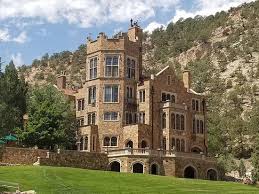 |
| Original Glen Eyrie Castle |
Last month, I wrote about General William Jackson Palmer and how he founded Colorado Springs. There is so much General Palmer did for Colorado Springs and Colorado that one blog would go on for pages, so I condensed that blog and I return today with another of the General’s accomplishments.

William Jackson Palmer
Military Wiki
While living in
Colorado Springs, Palmer built a grand home for himself and his wife (nicknamed
Queen) in the 1870’s. Situated just north of Garden of the Gods at the mouth of
a canyon, Glen Eyrie was originally a clapboard home of twenty rooms. While in
residence, Palmer’s wife taught school at Colorado Springs’ first school, but
more often than not, the Palmers were not in residence; she because of her
health and he because of his work. Suffering a heart attack wile pregnant with
their second child, Mrs. Palmer gave birth at the home then spent most of her
time on the East Coast or in England. She permanently left Glen Eyrie and
Colorado Springs in 1885 and passed away 1894.

Queen Palmer
Pinterest
With his daughters
coming to live with him after his wife’s passing, Palmer sold his Denver &
Rio Grande Western Railroad in 1901 for 6 million and retired in Colorado
Springs, where he donated several plots of land to the city while forging ahead
with plans to renovate Glen Eyrie. He hired architect Frederick J. Sterner and
engineer Edmond Van Dienst to help with the project, which took near two years
to quarry stone from the estate’s lands and transform the clapboard house into
a stone castle. With 67 rooms and 20 fireplaces, the interior was paneled in
oak, with the main floor boasting several parlors, a solarium, a dining room, and
a kitchen that had ice storage and a walk-in refrigerator. Bedroom suites for
Palmer and his daughters occupied the second level, as well as guest suites and
servants quarters. The third floor held more bedrooms, a sitting room, and
access to the tower, but the belle of the castle was Book Hall. Large enough to
hold 300 people, Book Hall boasted a large fireplace and a balcony where an
orchestra could perform. Beneath the hall were billiards rooms and a bowling
alley.

Renovated Glen Eyrie
PBS.org
Sadly, Palmer only
enjoyed his renovated home for a handful of years. Paralyzed from a horse
riding accident in 1906, he passed away 3 years later. His daughters wanted to
donate the castle to the city, but city leaders declined because they feared the
cost to maintain the property and home would be too high. For the next 40
years, Glen Eyrie saw many owners, though the house was rarely occupied, to include
a group of businessmen who wanted to turn the property into a golf resort, complete
with a tavern and luxury houses. World War 1 saw them changing their plans and
operating the castle as a tea room. Alexander S. Cochran bought the property in
1918, closed the castle because of the high expense to maintain and let it go
to ruin. He did build a ‘pink home’ on the property for a vacation house, and
passed away at the start of the Great Depression. The property sat on the
market until Texas oilman George W. Strake bought it in 1938. He expanded the pink house, opened the castle
for parties and used some of the land for ranching, and in 1953 listed Glen
Eyrie for sale at a price of $500,000, which caught Dawson Trotman’s attention.

Dawson Trotman
Find a Grave
A Christian
evangelist and founder of the Navigators ministry, Trotman was planning to move
from Los Angeles to Colorado and hoped to split the cost of Glen Eyrie with
fellow evangelist Billy Graham. Discovering Christians were interested in the property,
Strake lowered the sale price. With Graham backing out of the deal, Trotman quickly
raised the down payment with the help of his Navigators ministry and Glen Eyrie
became their home in September 1953, and remains so today. The Navigators use
the property as a home for their publishing firm, NavPress and as a Christian
conference center. The property came with a lake in the Rampart Range area and
now houses the Eagle Lake Camps, a Christian summer program. With the exception
of the kitchen and the removal of the bowling alley to incorporate a dining
area, the main part of the castle is unaltered. The castle and grounds are open
to visitors for afternoon tea (reservations required) a tour of the castle, and
an overnight stay within the castle, the pink house or the lodges the
Navigators built.



No comments:
Post a Comment
Our readers: If you like a post, please consider sharing on your Facebook and/or Twitter pages, and leave a comment. The cowgirls welcome them and will respond if you ask questions. Any Spam will be deleted.